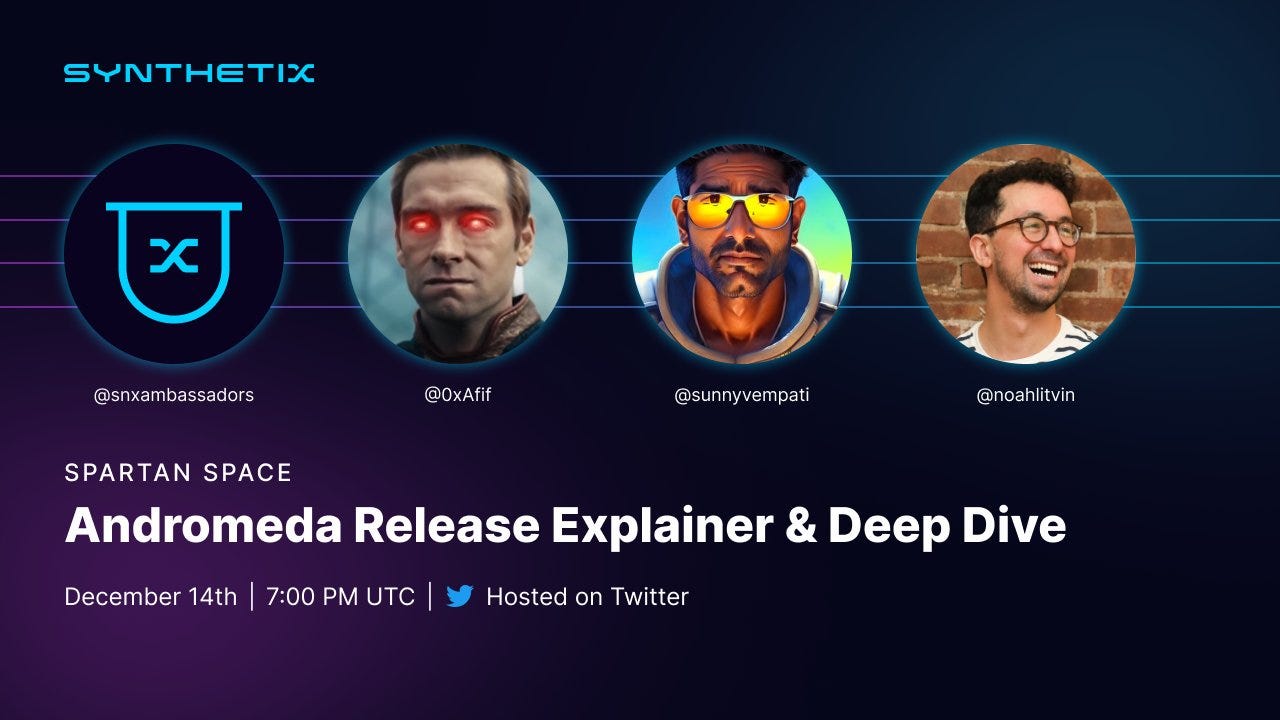Spartan Space Notes - The Andromeda Release - Dec 14 2023
Synthetix Perps V2 to V3 Evolution: Andromeda Release Spartan Space Highlights
What were the key factors behind the success of Synthetix Perps V2?
Synthetix has been involved in the perps race for years, and on-chain perps have shown much more interest recently. Perps V2 moved away from the tokenized synthetic asset model Synthetix was using and shifted towards credit-based liquidity provisioning. V2 has finally broken through in scaling perps infrastructure and has gotten there reliant on mechanism design and game theory by incentivizing arbitragers to keep markets neutral. It seems like we’ve hit limits in what the user base can support, but each wave of this gets higher every time as there is more demand.
With the introduction of USDC as a new collateral type in Andromeda, what impacts do you foresee on market liquidity and stability, and how might this influence trader and LP behavior?
Historically, Synthetix has had to solve two hard problems at once: a stablecoin and a derivatives protocol. This is both ambitious and becomes quadratically harder with two objectives. So, when you reach a point where demand gets too high and liquidity is constrained, this is compounded by the fact that the stablecoin starts to feel some headwinds. In V3, this is separated out, LPs can provide liquidity in USDC. In addition, if you look at the current model, SNX needs to be 500% overcollateralized. With USDC, this allows for much better capital efficiency and higher yield.
Has not having USDC stopped people from using Perps V2?
Having a decentralized stablecoin, the price can fluctuate a good amount based on flows of funds to and from perps trading, which can be tough in terms of UX. You want to easily go in and out of stablecoins with your positions, which is tougher with just sUSD. This will be much improved with Andromeda.
Can you (Afif/Sunny) elaborate on the key new features that are upgrading Perps V3 and how this is helping to bring Synthetix Perps into feature parity with CEX exchanges?
Cross Margin
Margin backing multiple positions at once.
Multi Collateral (spot synth collateral)
Can use synths as collateral, USDC, etc., but can expand from there via governance.
MEV-Resistant Liquidations
Can't have a centralized liquidation address anymore, so some configurable parameters mean liquidations happen progressively.
Deterministic Order Settlement Improvements
Users get better and more transparent prices.
What’s the initial release of Andromeda going to look like - with LP Caps, OI, market support, etc?
Starting on the mainnet with LP Caps that will be slowly raised over time. It's hard to say what the timeline looks like. The guess as to when it will be fully live is February.
What key metrics and indicators are being used to define the success of the Andromeda Release in the short to medium term?
First and foremost, make sure there are no critical bugs and that things work. Once things are up and running, we want to ensure the risk profile for LPs is as expected, seeing more people trade and plug in to scale the market. In particular, looking at LP returns being up and to the right is the most important thing.
Can you elaborate on the technical improvements introduced in Core V3 for the Perps V3 market?
The main goal was to set things up in as modular a process as possible. The flexibility will be a huge unlock: new collateral, new markets, new configurations, etc.
Built on the same router infrastructure as V2, building a “super-market.” It will be great once we get multiple “super-markets” in the wild. We should be able to ship new features very quickly.
The LP can pick which super-market they deploy to, which will depend on how governance decides to introduce how these markets are separated out. The core system and LPs have their debt paid off by the performance of the super-market.
How does the deployment of Andromeda on Base fit into Synthetix’s broader multi-chain strategy? What comes next?
We have a repository that has whatever features we want on each deployment, so cross-chain deployments are easy. We can manage an infinite number of them in theory.
Oracle implementations are a huge part of the protocol. The original EIP needed for this kind of thing was ERC-3668. It has some limitations, so it was replaced by ERC-7412, which can be explained as: If I need oracle data and it's not showing up, I can call something that fetches the data and puts it on-chain. This is a big unlock because as long as there's this verifier contract on-chain, the whole system can be deployed using that dependency. It allows for more cross-chain scalability.
Cross-chain queries would be similar, but rather than price feeds, it would be getting something like the amount of collateral backing the market on a different chain.
Goal: If the standard gets widely adopted, we can have all sorts of oracle networks that can be used, allowing end-users to make orders and have them settled with any price feeds without relying on keepers to write the data on-chain.
What can we anticipate for the future of Synthetix post-Andromeda?
Focusing on getting things right on Base first. Shift things over to V3 and into different deployments over time. Maybe move to another chain being entirely collateralized by ETH. We would also love to see the introduction of markets besides perps. Ensuring gas is not a limiting factor, and the introduction of new governance code for better decentralized governance will also be a goal in 2024.
Conclusion
Andromeda is live on Mainnet with minimal parameters as a testing ground. We are getting closer to launching it on Base. There will be plenty of communications to follow with respect to the move to Base.


